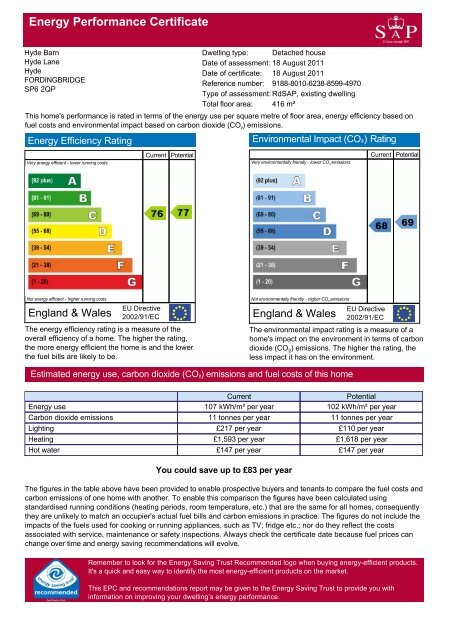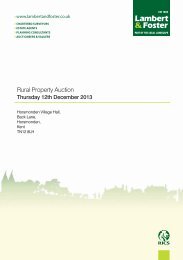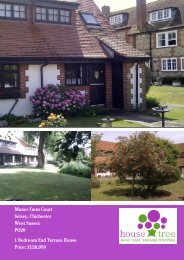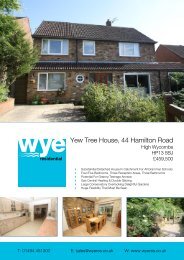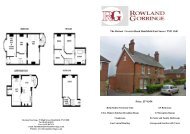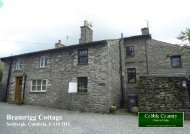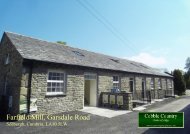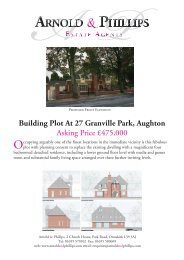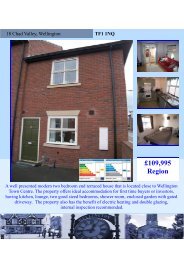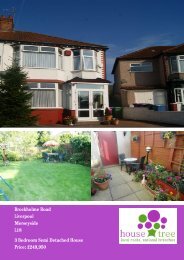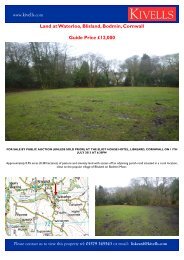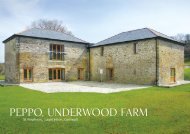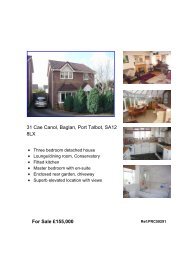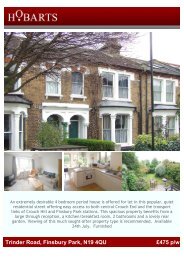Energy Performance Certificate - Expert Agent
Energy Performance Certificate - Expert Agent
Energy Performance Certificate - Expert Agent
You also want an ePaper? Increase the reach of your titles
YUMPU automatically turns print PDFs into web optimized ePapers that Google loves.
<strong>Energy</strong> <strong>Performance</strong> <strong>Certificate</strong><br />
Hyde Barn<br />
Hyde Lane<br />
Hyde<br />
FORDINGBRIDGE<br />
SP6 2QP<br />
Dwelling type: Detached house<br />
Date of assessment: 18 August 2011<br />
Date of certificate: 18 August 2011<br />
Reference number: 91888010623885994970<br />
Type of assessment: RdSAP, existing dwelling<br />
Total floor area: 416 m²<br />
This home's performance is rated in terms of the energy use per square metre of floor area, energy efficiency based on<br />
fuel costs and environmental impact based on carbon dioxide (CO ²<br />
) emissions.<br />
<strong>Energy</strong> Efficiency Rating<br />
Very energy efficient lower running costs<br />
Current Potential<br />
Environmental Impact (CO ² ) Rating<br />
Very environmentally friendly lower CO ²<br />
emissions<br />
Current Potential<br />
Not energy efficient higher running costs<br />
England & Wales<br />
EU Directive<br />
2002/91/EC<br />
The energy efficiency rating is a measure of the<br />
overall efficiency of a home. The higher the rating,<br />
the more energy efficient the home is and the lower<br />
the fuel bills are likely to be.<br />
Not environmentally friendly higher CO ²<br />
emissions<br />
England & Wales<br />
EU Directive<br />
2002/91/EC<br />
The environmental impact rating is a measure of a<br />
home's impact on the environment in terms of carbon<br />
dioxide (CO ) emissions. The higher the rating, the<br />
less impact it has on the environment.<br />
Estimated energy use, carbon dioxide (CO ²<br />
) emissions and fuel costs of this home<br />
Current<br />
Potential<br />
<strong>Energy</strong> use 107 kWh/m² per year 102 kWh/m² per year<br />
Carbon dioxide emissions 11 tonnes per year 11 tonnes per year<br />
Lighting £217 per year £110 per year<br />
Heating £1,593 per year £1,618 per year<br />
Hot water £147 per year £147 per year<br />
You could save up to £83 per year<br />
The figures in the table above have been provided to enable prospective buyers and tenants to compare the fuel costs and<br />
carbon emissions of one home with another. To enable this comparison the figures have been calculated using<br />
standardised running conditions (heating periods, room temperature, etc.) that are the same for all homes, consequently<br />
they are unlikely to match an occupier's actual fuel bills and carbon emissions in practice. The figures do not include the<br />
impacts of the fuels used for cooking or running appliances, such as TV, fridge etc.; nor do they reflect the costs<br />
associated with service, maintenance or safety inspections. Always check the certificate date because fuel prices can<br />
change over time and energy saving recommendations will evolve.<br />
Remember to look for the <strong>Energy</strong> Saving Trust Recommended logo when buying energyefficient products.<br />
It's a quick and easy way to identify the most energyefficient products on the market.<br />
This EPC and recommendations report may be given to the <strong>Energy</strong> Saving Trust to provide you with<br />
information on improving your dwelling’s energy performance.
Hyde Barn, Hyde Lane, Hyde, FORDINGBRIDGE, SP6 2QP<br />
18 August 2011 RRN: 91888010623885994970<br />
<strong>Energy</strong> <strong>Performance</strong> <strong>Certificate</strong><br />
About this document<br />
The <strong>Energy</strong> <strong>Performance</strong> <strong>Certificate</strong> for this dwelling was produced following an energy assessment undertaken by a<br />
qualified assessor, accredited by the NHER Accreditation Scheme, to a scheme authorised by the Government. This<br />
certificate was produced using the RdSAP 2009 assessment methodology and has been produced under the <strong>Energy</strong><br />
<strong>Performance</strong> of Buildings (<strong>Certificate</strong>s and Inspections) (England and Wales) Regulations 2007 as amended. A copy of<br />
the certificate has been lodged on a national register.<br />
Assessor's accreditation number: NHER002840<br />
Assessor's name:<br />
Company name/trading name:<br />
Address:<br />
Mr Michael Frith<br />
epcsouth<br />
Phone number: 01202 550190<br />
Fax number:<br />
Email address:<br />
Related party disclosure:<br />
99 Holdenhurst Road, Bournemouth, BH8 8DY<br />
mike.frith@epcsouth.com<br />
No related party<br />
If you have a complaint or wish to confirm that the certificate is genuine<br />
Details of the assessor and the relevant accreditation scheme are as above. You can get contact details of the<br />
accreditation scheme from their website at www.nesltd.co.uk together with details of their procedures for confirming<br />
authenticity of a certificate and for making a complaint.<br />
About the building's performance ratings<br />
The ratings on the certificate provide a measure of the building's overall energy efficiency and its environmental impact,<br />
calculated in accordance with a national methodology that takes into account factors such as insulation, heating and hot<br />
water systems, ventilation and fuels used. The average <strong>Energy</strong> Efficiency Rating for a dwelling in England and Wales is<br />
band E (rating 50).<br />
Not all buildings are used in the same way, so energy ratings use 'standard occupancy' assumptions which may be<br />
different from the specific way you use your home. Different methods of calculation are used for homes and for other<br />
buildings. Details can be found at www.communities.gov.uk/epbd<br />
Buildings that are more energy efficient use less energy, save money and help protect the environment. A building with a<br />
rating of 100 would cost almost nothing to heat and light and would cause almost no carbon emissions. The potential<br />
ratings on the certificate describe how close this building could get to 100 if all the cost effective recommended<br />
improvements were implemented.<br />
About the impact of buildings on the environment<br />
One of the biggest contributors to global warming is carbon dioxide. The way we use energy in buildings causes<br />
emissions of carbon. The energy we use for heating, lighting and power in homes produces over a quarter of the UK's<br />
carbon dioxide emissions and other buildings produce a further onesixth.<br />
The average household causes about 6 tonnes of carbon dioxide every year. Adopting the recommendations in this report<br />
can reduce emissions and protect the environment. You could reduce emissions even more by switching to renewable<br />
energy sources. In addition there are many simple everyday measures that will save money, improve comfort and reduce<br />
the impact on the environment. Some examples are given at the end of this report.<br />
Click www.epcadviser.direct.gov.uk our online tool which uses information from this EPC to show<br />
you how to save money on your fuel bills.<br />
Further information about <strong>Energy</strong> <strong>Performance</strong> <strong>Certificate</strong>s can be found under Frequently Asked Questions<br />
at www.epcregister.com<br />
NHER EPC On Line 7.0 (SAP 9.90)<br />
Page 2 of 6
Hyde Barn, Hyde Lane, Hyde, FORDINGBRIDGE, SP6 2QP<br />
18 August 2011 RRN: 91888010623885994970<br />
Recommendations<br />
Recommendations<br />
The measures below are cost effective. The performance ratings after improvement listed below are cumulative, that is<br />
they assume the improvements have been installed in the order that they appear in the table. The indicative costs are<br />
representative for most properties but may not apply in a particular case.<br />
Lower cost measures<br />
Indicative cost<br />
Typical savings<br />
per year<br />
Ratings after improvements<br />
<strong>Energy</strong> Environmental<br />
efficiency impact<br />
1 Low energy lighting for all fixed outlets £163 £83 C 77 C 69<br />
Total £83<br />
Potential energy efficiency rating C 77<br />
Potential environmental impact (CO 2<br />
) rating C 69<br />
Further measures to achieve even higher standards<br />
The further measures listed below should be considered in addition to those already specified if aiming for the highest<br />
possible standards for this home. However you should check the conditions in any covenants, planning conditions,<br />
warranties or sale contracts. The indicative costs are representative for most properties but may not apply in a particular<br />
case.<br />
2 Solar photovoltaic panels, 2.5 kWp £11,000 £20,000 £214 C 80 C 71<br />
3 Wind turbine £1,500 £4,000 £76 B 81 C 72<br />
Enhanced energy efficiency rating B 81<br />
Enhanced environmental impact (CO 2<br />
) rating C 72<br />
Improvements to the energy efficiency and environmental impact ratings will usually be in step with each other. However,<br />
they can sometimes diverge because reduced energy costs are not always accompanied by a reduction in carbon<br />
dioxide (CO ²<br />
) emissions.<br />
Page 3 of 6
Hyde Barn, Hyde Lane, Hyde, FORDINGBRIDGE, SP6 2QP<br />
18 August 2011 RRN: 91888010623885994970<br />
<strong>Energy</strong> <strong>Performance</strong> <strong>Certificate</strong><br />
Summary of this home's energy performance related features<br />
The table below gives an assessment of the key individual elements that have an impact on this home's energy and<br />
environmental performance. Each element is assessed by the national calculation methodology; 1 star means least<br />
efficient and 5 stars means most efficient. The assessment does not take into consideration the physical condition of any<br />
element. "Assumed" means that the insulation could not be inspected and an assumption has been made in the<br />
methodology based on age and type of construction.<br />
Element<br />
Walls<br />
Roof<br />
Description<br />
Cavity wall, as built, insulated (assumed)<br />
Pitched, 300+ mm loft insulation<br />
Roof room(s), insulated<br />
Current performance<br />
<strong>Energy</strong> Efficiency Environmental<br />
Floor Solid, insulated (assumed) <br />
Windows<br />
Main heating<br />
Main heating controls<br />
Fully double glazed<br />
Boiler and underfloor heating, oil<br />
Programmer and at least two room thermostats<br />
Secondary heating None <br />
Hot water<br />
Lighting<br />
From main system<br />
Low energy lighting in 2% of fixed outlets<br />
Current energy efficiency rating C 76<br />
Current environmental impact (CO 2<br />
) rating D 68<br />
Low and zero carbon energy sources<br />
None<br />
Page 4 of 6
Hyde Barn, Hyde Lane, Hyde, FORDINGBRIDGE, SP6 2QP<br />
18 August 2011 RRN: 91888010623885994970<br />
Recommendations<br />
About the cost effective measures to improve this home's performance ratings<br />
If you are a tenant, before undertaking any work you should check the terms of your lease and obtain approval from your<br />
landlord if the lease either requires it, or makes no express provision for such work.<br />
Lower cost measures<br />
These measures are relatively inexpensive to install and are worth tackling first. The indicative costs of measures<br />
included earlier in this EPC include the costs of professional installation in most cases. Some of the cost effective<br />
measures below may be installed as DIY projects which will reduce the cost. DIY is not always straightforward and<br />
sometimes there are health and safety risks, so take advice before carrying out DIY improvements.<br />
1 Low energy lighting<br />
Low energy light bulbs last up to 12 times longer than ordinary ones and reduce lighting costs.<br />
About the further measures to achieve even higher standards<br />
Further measures that could deliver even higher standards for this home. You should check the conditions in any<br />
covenants, planning conditions, warranties or sale contracts before undertaking any of these measures. If you are a<br />
tenant, before undertaking any work you should check the terms of your lease and obtain approval from your landlord if<br />
the lease either requires it, or makes no express provision for such work.<br />
2 Solar photovoltaic (PV) panels<br />
A solar PV system converts light directly into electricity via panels placed on the roof and can be used throughout the<br />
home. Building Regulations apply to this work and planning restrictions may apply. You could be eligible for a Feedin<br />
Tariff which could appreciably increase the savings beyond those shown on your EPC, provided that both the product<br />
and the installer are certified by the Microgeneration Certification Scheme (or equivalent). Details of local MCS installers<br />
are available at www.microgenerationcertification.org.<br />
3 Wind turbine<br />
A wind turbine provides electricity from wind energy. This electricity can be used throughout the home. Building<br />
Regulations apply to this work and planning restrictions may apply. Wind turbines are not suitable for all properties. The<br />
system’s effectiveness depends on local wind speeds and the presence of nearby obstructions, and a site survey<br />
should be undertaken by an accredited installer. You could be eligible for a Feedin Tariff which could appreciably<br />
increase the savings beyond those shown on your EPC, provided that both the product and the installer are certified by<br />
the Microgeneration Certification Scheme (or equivalent). Details of local MCS installers are available at<br />
www.microgenerationcertification.org.<br />
Page 5 of 6
Hyde Barn, Hyde Lane, Hyde, FORDINGBRIDGE, SP6 2QP<br />
18 August 2011 RRN: 91888010623885994970<br />
Recommendations<br />
What can I do today?<br />
Actions that will save money and reduce the impact of your home on the environment include:<br />
Ensure that you understand the dwelling and how its energy systems are intended to work so as to obtain the<br />
maximum benefit in terms of reducing energy use and CO 2<br />
emissions.<br />
Check that your heating system thermostat is not set too high (in a home, 21°C in the living room is suggested) and<br />
use the timer to ensure that you only heat the building when necessary.<br />
Make sure your hot water is not too hot a cylinder thermostat need not normally be higher than 60°C.<br />
Turn off lights when not needed and do not leave appliances on standby. Remember not to leave chargers (e.g. for<br />
mobile phones) turned on when you are not using them.<br />
Close your curtains at night to reduce heat escaping through the windows.<br />
If you're not filling up the washing machine, tumble dryer or dishwasher, use the halfload or economy programme.<br />
Check the draughtproofing of windows and replace it if appropriate.<br />
If you have unused open chimneys consider blocking them off (making provision for a ventilation opening and a cowl<br />
on top of the chimney to avoid dampness).<br />
For advice on how to take action and to find out about offers available to help make your home more energy efficient, call<br />
0800 512 012 or visit www.energysavingtrust.org.uk.<br />
Page 6 of 6


